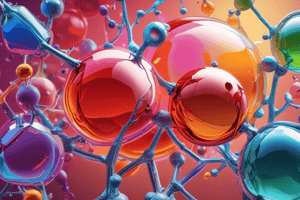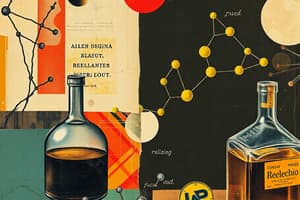Podcast
Questions and Answers
Which of the following factors increases the acidity of alcohols?
Which of the following factors increases the acidity of alcohols?
- Increasing the number of alkyl groups attached to the carbon bearing the hydroxyl group
- Introducing an electron-withdrawing group near the hydroxyl group (correct)
- Increasing the size of the alkyl group attached to the hydroxyl group
- Increasing the electronegativity of the atom attached to the hydroxyl group
Flashcards
Acidity of Alcohols
Acidity of Alcohols
Alcohols can donate protons (H+) when dissolved in water, affecting pH.
Basicity of Alcohols
Basicity of Alcohols
Alcohols can accept protons, making them weak bases.
Formation of Alkyl Halides
Formation of Alkyl Halides
Alcohols react with halogenating agents to form alkyl halides.
Oxidation of Alcohols
Oxidation of Alcohols
Signup and view all the flashcards
Phenols
Phenols
Signup and view all the flashcards
Study Notes
Alcohols and Phenols
- Alcohols are organic compounds containing a hydroxyl (-OH) group attached to a carbon atom.
- Phenols are aromatic compounds containing a hydroxyl (-OH) group bonded directly to an aromatic ring.
Types of Alcohols
- Methanol (methyl alcohol)
- Ethanol (ethyl alcohol)
- 1-propanol (n-propyl alcohol)
- 2-propanol (isopropyl alcohol)
- 1-butanol (n-butyl alcohol)
- 2-butanol (sec-butyl alcohol)
- 2-methyl-1-propanol (isobutyl alcohol)
- 2-methyl-2-propanol (tert-butyl alcohol)
- 2-propen-1-ol (allyl alcohol)
- Cyclohexanol (cyclohexyl alcohol)
- Phenylmethanol (benzyl alcohol)
Types of Phenols
- Phenol
- p-chlorophenol
- 2,4,6-tribromophenol
- m-hydroxybenzoic acid
- p-hydroxybenzaldehyde
- p-nitrophenol
- 2,4-dinitrophenol
Physical Properties of Alcohols
- Boiling Point: Increases with increasing molecular weight due to stronger intermolecular forces
- Solubility: Low molecular weight alcohols are completely miscible with water due to hydrogen bonding; as the carbon chain lengthens, solubility decreases.
- Examples of boiling points and solubility of alcohols are listed in Table 7.1
Acidity of Alcohols and Phenols
- Alcohols are weakly acidic and phenols are more acidic because of resonance stabilization.
Reactions of Alcohols
- Reaction with sodium metal: Alcohols react with sodium metal to produce hydrogen gas and sodium alkoxide.
- Formation of alkyl halides: Alcohols react with halogen acids (HX) to form alkyl halides via SN1 or SN2 mechanisms
- Oxidation Primary alcohols can be oxidized to aldehydes and then to carboxylic acids; secondary alcohols are oxidized to ketones.
- Various oxidizing agents like K₂Cr₂O₇, H₂SO₄, CuO, Jones' reagent and PCC are used
Reactions of Phenols
- Reaction with nitric acid: Phenols react with dilute nitric acid to form nitrophenols, and with concentrated nitric acid to form trinitrophenol (picric acid).
- Reaction with Bromine: Phenol reacts with Bromine to form 2,4,6-tribromophenol
Thiols
- Similar to alcohols, but with a sulfur atom instead of an oxygen.
Studying That Suits You
Use AI to generate personalized quizzes and flashcards to suit your learning preferences.




